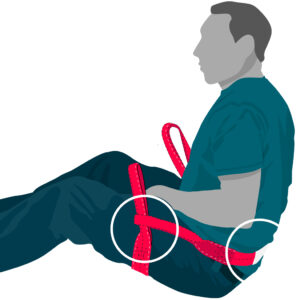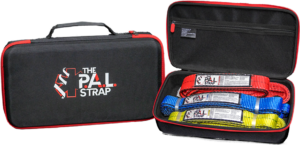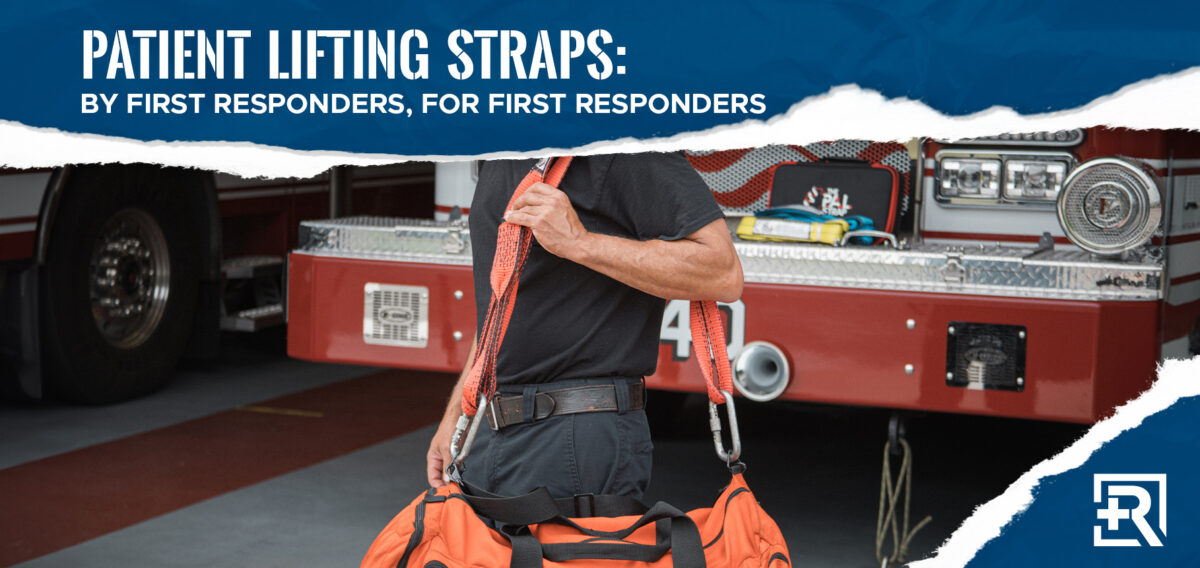Patient Lifting Straps for EMS and First Responders
Patient Lifting Straps for EMS and First Responders
Patient Lifting Straps for EMS and First Responders
The PAL Strap is a revolutionary tool for EMS providers, quickly becoming a staple for every ambulance, fire engine, and emergency vehicle. Designed by a firefighter who wanted to improve the risky and unreliable “lift-with-bedsheets” process, the PAL strap is a versatile tool that speeds up the lifting process, reduces liability, improves comfort for the patient, and reduces strain on the responders.
How do you lift patients?
Every day, firefighters, paramedics, assisted care workers, and any emergency responder who’s been on a patient lift call tell us they’re still lifting fallen patients with bedsheets. Lifting with bedsheets is unsanitary for the responder, is a different assembly each time, and introduces risks of slipping, ripping, or disbalancing an elderly or bariatric patient. Bedsheets have no instructions for proper assembly and, therefore, are never assembled the same way twice. Sheets can’t be trusted to safely lift the patient or protect the responder from back injury. This level of liability is almost unimaginable in this day and age.
How should you lift patients?
 The PAL Strap is a simple, belt-like strap that goes under a patient’s legs and behind their back to form a stable basket with a lifting handle on each side. In addition to the lifting handles, the back strap offers reliable, easy purchase points, especially compared to bedsheets. Once assembled around the patient, EMS locks their front foot in front of the patient, creating a leverage point. Because of the weight distribution and the accessible lifting handles, assisting the patient to their feet from here takes a fraction the effort of other methods. With this approach, small responders can easily and safely lift much larger patients without fear of injury to themselves or the victim.
The PAL Strap is a simple, belt-like strap that goes under a patient’s legs and behind their back to form a stable basket with a lifting handle on each side. In addition to the lifting handles, the back strap offers reliable, easy purchase points, especially compared to bedsheets. Once assembled around the patient, EMS locks their front foot in front of the patient, creating a leverage point. Because of the weight distribution and the accessible lifting handles, assisting the patient to their feet from here takes a fraction the effort of other methods. With this approach, small responders can easily and safely lift much larger patients without fear of injury to themselves or the victim.
 The PAL Strap can also lift a patient directly up from a seated position. This technique can move a patient to a stair chair, wheelchair, or bed. Additionally, most first responders can, with lifters on either side, raise a patient into a cot or stretcher. This same technique can also lift a patient out of a car seat or from a stretcher to a hospital bed.
The PAL Strap can also lift a patient directly up from a seated position. This technique can move a patient to a stair chair, wheelchair, or bed. Additionally, most first responders can, with lifters on either side, raise a patient into a cot or stretcher. This same technique can also lift a patient out of a car seat or from a stretcher to a hospital bed.
The PAL strap comes in a rugged kit with three sizes: Regular, Large, and X-Large. The regular strap (red) will be your primary strap, suitable to lift at least 90% of your patients. EMS have even started replacing their medical bag’s default strap with a red PAL strap and two carabiners, further improving the usefulness and utility of their bag and ensuring a lift-assist strap is with their go-bag at all times.
 The PAL strap is ideal for scenarios where minimal intrusion is needed. For example, when the fire department needs to lift a patient quickly without intruding on the privacy or personal life of the patient to regain their comfort and maintain their dignity.
The PAL strap is ideal for scenarios where minimal intrusion is needed. For example, when the fire department needs to lift a patient quickly without intruding on the privacy or personal life of the patient to regain their comfort and maintain their dignity.
Best of all, the PAL strap disassembles in seconds. Removing the bedsheets from underneath a lifted patient is a chore. Paramedics shimmy the patient around, wrestling to scoot the sheets out from underneath. With the PAL Strap, you simply pull the loop apart and slide the strap out from behind the patient’s back. We aren’t kidding when we say an experienced paramedic can disassemble the strap and remove it from a patient in under five seconds.
The PAL Strap prioritizes both patient comfort and first responder safety. The patient’s weight secures the girth hitch and ensures the patient is stable and at ease throughout the lifting process. Equally important, however, caregivers guarantee a snug and comfortable fit by confirming the strap’s presence around the thighs and providing support along the back. The PAL Strap has two strong handles that naturally provide patient stability and minimize extra strain on the EMS provider.
The PAL Strap comes in a kit of three straps and includes the Standard, Large, and X-Large sizes. Choosing which strap to use is based on the patient’s build, not weight. A kit costs only $219 and, when used correctly, greatly reduces possible liability for fallen patients. With its commitment to standardized techniques and provider safety, the PAL Strap sets the bar for EMS-first lift-assist solutions. Purchase or learn more about the PAL strap here, or contact us today for bulk order discounts.



